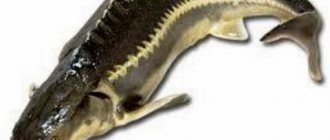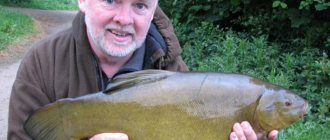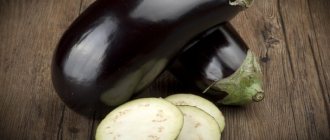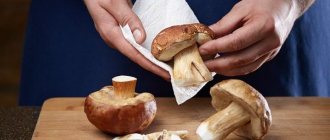- October 27, 2018
- Cooking
- Natalya AlfaScorp
Burbot is a royal fish with excellent taste. Experienced fishermen know various ways to catch such a “king” on a hook in order to enjoy such a delicacy. Recommendations on how to clean burbot will be useful not only for those who cannot imagine its taste without the skin, but also for those for whom this skin is not considered an important part of this capricious fish.
Operation "stocking"
The first step is to place the fish on a cutting board, then place two index fingers deep under the gill cover and begin to separate the skin. Make an incision in the skin around the head. Grab the skin with pliers and slowly pull it off. Carefully rip open the belly, since the skin of the burbot is quite thin. Remove the entrails and cut off the head. The skin does not have to be thrown away; it can be used when preparing rich fish soup. After reading the advice on how to clean burbot, you can begin practical steps, and then fry the delicious fish in a frying pan or cook it boiled.
How to properly clean burbot: methods of cleaning and cutting, cooking recipes
- First of all, it is necessary to clean the carcass of mucus - this will simplify the cleaning task, since the fish will slip out of your hands less. To do this, you need to thoroughly rub it with coarse salt and then rinse well.
- After this, use a sharp knife to cut the skin around the head. They cut the burbot skin behind the gill slits.
- Now comes the most difficult part: you need to firmly grasp the fish and, picking up the edge of the skin with pliers, gently pull it down so that it takes on the appearance of a “stocking.” Usually the skin of burbot is dense and strong, so it can be easily removed.
An alternative method of preparing fish for frying involves removing the skin at the end of the cutting process.
So as not to spoil the skin
Many connoisseurs of burbot dishes are of the opinion that the most “tsimus” lies precisely in its elastic skin. The method of cleaning this fish without interfering with its skin is suitable for them. First you need to make cuts in the head area, grab the gills, open and remove the insides. The first thing that will be asked to “go out” is the rectum, and then all the other offal. Rinse the fish, remove dirt and start cooking it. Cut off the head for fish soup, breaking the bone, the rest can be cut into medium pieces and fried. The problem of how to clean burbot in an easy way without removing the skin has been solved. The fish is quite slippery, so professionals recommend wearing gloves when cutting.
Skin removal
The skin of burbot is hard, tough and not suitable for food, even if the scales are removed from it. Therefore, it must be removed, which can be done with pliers or similar tools. Without them, skinning will be quite problematic
- First of all, it is necessary to clean the carcass of mucus - this will simplify the cleaning task, since the fish will slip out of your hands less. To do this, you need to thoroughly rub it with coarse salt and then rinse well.
- After this, use a sharp knife to cut the skin around the head. They cut the burbot skin behind the gill slits.
- Now comes the most difficult part: you need to firmly grasp the fish and, picking up the edge of the skin with pliers, gently pull it down so that it takes on the appearance of a “stocking.” Usually the skin of burbot is dense and strong, so it can be easily removed.
Cutting up large catches
Experienced fishermen in their master classes share useful tips on how to clean burbot weighing 5 kilograms or more. The skin of this fish is dense and many professionals strongly recommend getting rid of it. Place the catch on the newspaper and perform the following steps:
- Using a sharp knife, cut the skin of the burbot near the head, then carefully tear it off, grabbing the edge with pliers.
- Carefully open the peritoneum and separate the eggs.
- Then remove the liver without damaging the gall bladder, otherwise the whole taste of the fish will spoil. The bubble should be removed very carefully so that it does not burst or spread. This inside gives an unpleasant bitterness and it is better to get rid of it.
- Remove the remaining innards and rinse the carcass.
After following the recommendations on how to clean burbot for frying, you can begin preparing it.
How to clean it properly?
Cutting burbot for frying is not a difficult task. This can be done in two ways, differing from each other in that in the first case the skin is removed before cutting, and in the other (alternative) - after.
In a professional kitchen, special devices are used to cut burbot. At home you can make do with familiar items.
You can prepare burbot by having on hand:
- a special board that is used exclusively for fish. If there is none, you can replace it with a sheet of thick paper;
- scissors and a sharp knife (ideally use a special fish knife);
- pliers for gripping slippery skin;
- tweezers for removing bones;
- coarse salt to cleanse the mucous coating.
Skin removal
The first thing to do before frying is to remove the skin.
To remove it:
- rub the burbot with coarse salt, then rinse it off with water at room temperature. This helps cleanse the skin of surface mucus and scales;
- cut off the fins using scissors or pull them out with pliers, making cuts along each;
- make an incision in the skin around the head in the area where it joins the body;
- grab the burbot skin with your fingers or pliers and carefully remove it (you should get a stocking);
- carefully examine the subcutaneous layer for the presence of parasites. If the latter are present, problem areas are cut out.
Advice! If the skin of the burbot comes off with difficulty, it is recommended to carefully trim it with a knife during the pulling process.
Video of the process sequence:
Removing the entrails
The entrails should be removed carefully so as not to damage the integrity of the internal organs and to prevent their contents from entering the cavity of the fish.
For this purpose:
- make a neat incision from the anal fin to the base of the head;
- take out the insides. It is better to do this with your hands, because a knife can pierce the gallbladder and hopelessly ruin the product;
- remove the inner film by prying it off with the end of a sharp knife;
- washed with water at room temperature.
Fish cutting
How to cut burbot for frying?
During the cutting process:
- cut off the edge of the abdomen (tesha);
- carefully remove the liver and remove the head;
- cut the carcass into pieces of the required size;
- if it is necessary to obtain a fillet, make a cut along the spine and divide the carcass into two parts;
- remove the bones using tweezers.
Watching the video will help you properly cut fish for frying:
Thinning process
Lay a clean newspaper and place the washed, cleaned fish on it. Hook the upper fin with pliers and tear it off; do the same with the lower one. Then, using a fillet knife, starting from the head and along the line of the spine, cut the carcass and slowly separate all the meat. Cut off the remaining fins. The remaining ridge with the head will serve as an excellent ingredient for fish soup.
Burbot: features of the species
Burbot is a freshwater fish of the burbot family, order of codfish. Adults of the species can grow up to 120 cm in length.
Representatives of burbot are characterized by the presence of a long, elongated body and a serpentine head, equipped with three mustaches (two on the upper jaw and one on the chin), as well as a large number of small bristle-like teeth.
The abdomen is white with a yellow tint. The body, depending on the age and habitat of the individual, can have a dark or light gray-green color. A characteristic feature of the species is the presence of brown stripes and spots on the back. The body of the burbot is covered with small, almost invisible scales. Long, low fins are located on the back, near the throat and in the tail area.
The meat is white, similar to cod, the structure is dense. The content of proteins, polyunsaturated fatty acids and minerals in meat makes burbot a product beneficial for human health.
Fried fillet in batter
Before you start preparing the dish, you need to clean the fish, removing the skin, and fillet it. How to clean burbot fish is described in the recommendations above. Chop the onion. Pour flour onto a plate, roll each piece of fish and place in a heated frying pan. Salt, season with pepper and fry on both sides. If you have milk, you can also roll it in flour and fry it. After finishing cooking the fish, pour the chopped onion into the same frying pan and sauté until golden brown.
Burbot cutlets
Before preparing this most delicate dish according to a fisherman’s recipe, you need to know how to clean and cook burbot. Be sure to remove the skin.
Ingredients:
- Burbot.
- Lard - 200 g.
- White bread - 200 g.
- A glass of milk.
- Two eggs.
- A couple of bulbs.
- A clove of garlic.
- Salt and pepper.
- Flour for frying.
Cooking process:
- Soak slices of white bread in milk. Peel the onion.
- Cut up the burbot. How to clean burbot is described in the recommendations for cutting fish for consumption without skin. Place liver and caviar on a separate plate.
- Grind the burbot fillet through a meat grinder along with onions, chopped lard and swollen bread crumbs.
- Season the resulting minced meat with salt and pepper and mix with your hands.
- Beat in two eggs and continue kneading the fish mass.
- Grate or pass the garlic through a press into the minced meat and stir again.
- Place flour on a dry plate.
- Pour oil into a frying pan and heat it up.
- Form small cutlets, roll in flour and fry on both sides.
- Also roll the remaining liver with caviar in flour and fry in the same oil where the cutlets were cooked.
Serve the finished creation with sauerkraut.
Rich ear
Experienced fishermen share the secret of preparing a delicious fish soup from a large five-kilogram burbot - freshwater cod. This fish is famous for its large liver, which is also used as a delicacy. First you need to prepare potatoes, two carrots, three onions and cut up the catch. Each fisherman offers his own advice on how to clean burbot. It can be divided as follows:
- Defrost the fish.
- First you need to separate the head and tail.
- Next, cut the skin along the entire burbot and use pliers to tear it off. Set the skin aside; it will be useful for the broth.
- Separate the carcass with the ridge from the entrails, remove the gall bladder from the liver.
- Remove meat from bones and place in a separate bowl.
The process of cooking fish soup:
- Throw the skin, head, ridge and tail into a large saucepan with thick walls, add cold water and cook over low heat for 20-40 minutes. At the moment of boiling, add coarsely chopped carrots and onions into the broth.
- Wash the meat and liver and cut into portions.
- Strain the finished broth, throw away all waste and vegetables or give it to your pets.
- Pour the strained broth into a clean saucepan and heat.
- Add the chopped third onion, carrot slices and potato cubes. Season the ingredients with coarse salt and bring to a boil.
Add chopped fillet and liver to the boiling broth. Add a little bay leaf and pepper. Cook for another 20 minutes over low heat. At the end of cooking, you can add herbs if desired.
Preparation
To cut fish you will need: coarse table salt, a knife, kitchen scissors, a cutting board, tweezers, pliers, paper. It is not necessary to buy special tools for removing the skin; you can use a sharp knife.
To cut the carcass, take a glass board. It is better washed off from particles of meat and smell. The pliers will help hold the skin while removing. You can wash off the mucus with coarse salt by rubbing the carcass with it.
Advantages and disadvantages of fish cutting devices
Every housewife should find a convenient fish processing tool for herself. Let's look at the pros and cons of different devices.
- A knife is ideal for cutting. You need to choose a quality tool that fits comfortably in your hand.
- The downside is that scales with mucus stick to the edge of the knife, which are difficult to get rid of.
- Pliers – convenient for picking up the skin. The downside is that it takes time to adapt to them.
- Hooks and clamps are designed for cleaning fish, but they can be awkward to use for beginners.
- Tweezers - can successfully remove the skin, but often slips out of your hands.
- Scissors - help cut off the tail and fins.











